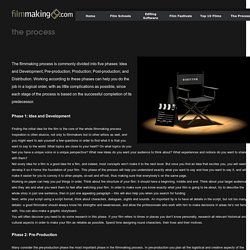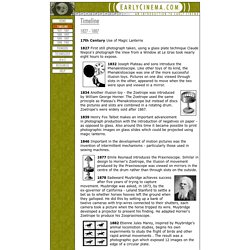

How to make a film with your iPhone or iPad. 9 August 2016 What you need You can use any current iPhone, iPad – or the iPod Touch – for filmmaking.

All you need are Apple’s built-in apps Camera and Photos, plus iMovie for editing. You can also use Garageband to create a soundtrack. Basic Camera Shots for Filmmaking. Basic Shot Types. Basic Camera Shots, Angles, and Movements. The process. The filmmaking process is commonly divided into five phases: Idea and Development; Pre-production; Production; Post-production; and Distribution.

Working according to these phases can help you do the job in a logical order, with as little complications as possible, since each stage of the process is based on the successful completion of its predecessor. Phase 1: Idea and Development Finding the initial idea for the film is the core of the whole filmmaking process. Inspiration is often elusive, not only to filmmakers but to other artists as well, and you might want to ask yourself a few questions in order to find what it is that you want to say to the world: What topics are close to your heart?
On what topics do you feel you have a unique voice or a unique perspective? Not every idea for a film is a good idea for a film, and indeed, most concepts won’t make it to the next level. Working on paper can help you put things in order. Phase 2: Pre-Production Phase 3: Production. The History of Film by HistoryShots. Le Voyage dans la lune : Georges Méliès. A Trip to the Moon (and Five Other Free Films) by Georges Méliès, the Father of Special Effects. If you've taken a film studies course, you've almost certainly seen the work of Georges Méliès.

His 1902 short A Trip to the Moon, at the top, which some cinema scholars cite as the picture where special effects as we know them began, has a particularly important place in cinema history. Nobody who watches that fourteen-minute production ever forgets the image of the moon's consternation after the protagonists' spacecraft crashes into it. And the rest of the movie, if narratively shaky, still has an impressive visual power. If anybody had both sufficient imagination and sufficient know-how to commit such a voyage to that cutting-edge medium known as motion film over a century ago, the theater owner and seasoned illusionist Méliès did. Charged by the cinematic pioneering of his countrymen the Lumière brothers, he began doing it in 1896, and continued until 1913, which makes A Trip to the Moon a mid-career highlight.
They will all be added to our collection of 550 Free Movies Online. History of Cinema - Timeline. 17th Century Use of Magic Lanterns 1827 First still photograph taken, using a glass plate technique Claude Niepce's photograph the View from a Window at Le Gras took nearly eight hours to expose. 1832 Joseph Plateau and sons introduce the Phenakistoscope.

Like other toys of its kind, the Phenakistoscope was one of the more successful illusion toys. Pictures on one disc viewed through slots in the other, appeared to move when the two were spun and viewed in a mirror. 1834 Another illusion toy - the Zoetrope was introduced by William George Horner. 1839 Henry Fox Talbot makes an important advancement in photograph production with the introduction of negatives on paper - as opposed to glass. 1846 Important in the development of motion pictures was the invention of intermittent mechanisms - particularly those used in sewing machines. 1877 Emile Reynaud introduces the Praxinoscope. 1878 Eadweard Muybridge achieves success after five years of trying to capture movement. Top. The History of The Discovery of Cinematography - 1885 - 1889. Earliest Extant Film: Roundhay Garden Scene of 14 October, 1888 From Louis Aime Augustin Le Prince No other strip of film has ever been produced which pre-dates this one.

It is known as the Roundhay Garden Scene (right). Le Prince photographed this sequence (2-3 weeks prior to Leeds) in the garden of the Whitley home, (home of his father-in-law) Roundhay, Leeds. This 'film' was never shown by Le Prince and exists today only as a result of photographic copies of the original paper frames (made by the NMPFT in 1930), and reconstructed animations.